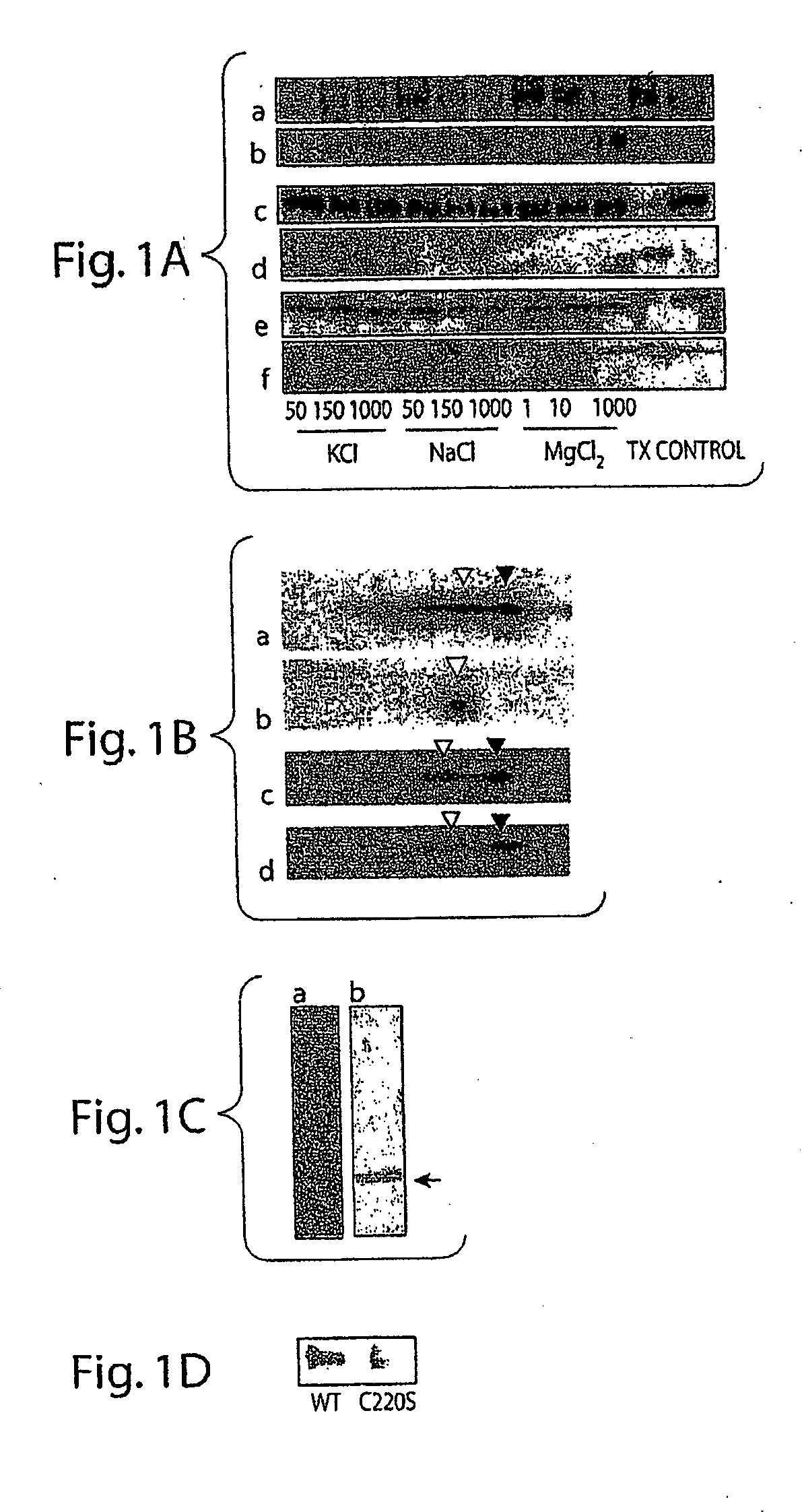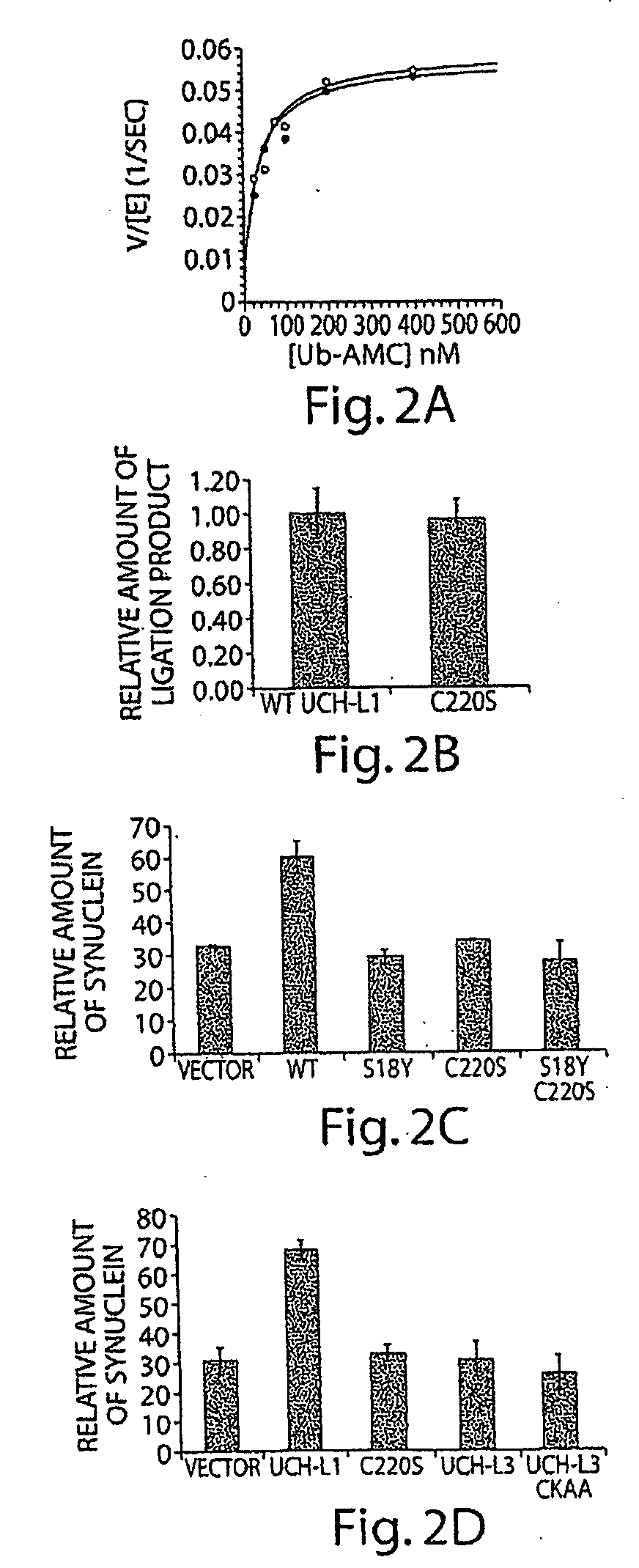Quinolinone farnesyl transferase inhibitors for the treatment of synucleinopathies and other indications
a technology of farnesyl transferase and quinolinone, which is applied in the field of new drugs, can solve problems such as dementia and interfere with a person's ability to function, and achieve the effects of improving the ability of the body to function and improving the effect of oxidative stress
- Summary
- Abstract
- Description
- Claims
- Application Information
AI Technical Summary
Benefits of technology
Problems solved by technology
Method used
Image
Examples
example 1
UCH-L1 is Farnesylated in Vivo and in Cell Culture
[0411]The UCH-L1 sequence contains the sequence CXXX, a consensus farnesylation site, at its C-terminus. This sequence is not present in UCH-L3. The possibility that this sequence was modified in vivo was investigated. First, the chemical nature of the previously reported association of UCH-L1 and synaptic vesicles from rat brain was probed.
[0412]The results are shown in FIG. 1, panel A: Effects of various amount of salt and non-ionic detergent on the dissociations of synapsin I, synaphysin and UCH-L1 from SV was analyzed by treating aliquots of SV fraction with either KCl, NaCl, MgCl2, or 1% Triton X-100. Membrane fraction and soluble fraction was separated by centrifugation and each fraction was subjected to SDS-PAGE followed by Western blots. a (synapsin I), c (synaphysin) and e (UCH-L1) are from pellet, and b (synapsin I), d (synaphysin) and f (UCH-L1) are supernatant fractions. Unlike synapsin (FIG. 1, panel A, rows a and b), wh...
example 2
Removal of the Farnesyltation Site has No Effect on the in Vitro Enzymatic Activity or Aggregation Properties of UCH-L1
[0415]The C220S mutant as expressed in E. coli and purified using a published method. As expected from examination of structural models of UCH-L1, the point mutation had no effect on the in vitro hydrolase (FIG. 2, panel A) or ligase (panel B) activities. (A) Michaelis-Menten plot of various amount Ub-AMC titrated against either UCH-L1 WT (close circle) or C220S (open circle) showed comparable hydrolytic activities. (B) The mutation does not affect UCH-L1 in vitro ligase activity. In addition, the C220S mutation did not eliminate the propensity of S18 to oligomerize. This finding cleared the way to examine the effects of C220S in cell culture.
example 3
Farnesylation and Membrane Association of Uch-L1 is Required to Promote Accumulation of α-Synuclein in COS-7 Cells
[0416]The C220S mutation eliminated the ability of S118 to promote α-synuclein accumulation in COS-7 cells but had no effect on the S18Y polymorph (FIG. 2, panel C): the relative amount of 16 kDa α-synuclein was quantified and normalized against the amount of actin in transfected COS-7 cells with the presence of UCH-L1 variants. 100% accumulation of α-synuclein was achieved in cells treated with the proteasome inhibitor lactacystin). This finding suggested that farnesylation and membrane attachment of UCH-L1 are both required. In order to isolate the latter possibility, a mutant form of UCH-L3 was constructed in which the UCH-L1 faresylation sequence was added to the UCH-L3 C-terminus. This protein did not cause accumulation of α-synuclein (panel D): The relative amount of α-synuclein in COS-7 cells transfected with UCH-L1 and UCH-L3 variants was compared), although it w...
PUM
| Property | Measurement | Unit |
|---|---|---|
| body weight | aaaaa | aaaaa |
| body weight | aaaaa | aaaaa |
| pH | aaaaa | aaaaa |
Abstract
Description
Claims
Application Information
 Login to View More
Login to View More - R&D
- Intellectual Property
- Life Sciences
- Materials
- Tech Scout
- Unparalleled Data Quality
- Higher Quality Content
- 60% Fewer Hallucinations
Browse by: Latest US Patents, China's latest patents, Technical Efficacy Thesaurus, Application Domain, Technology Topic, Popular Technical Reports.
© 2025 PatSnap. All rights reserved.Legal|Privacy policy|Modern Slavery Act Transparency Statement|Sitemap|About US| Contact US: help@patsnap.com



